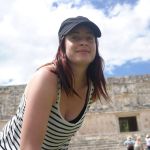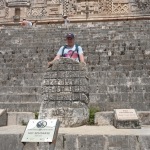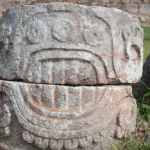Took our first tour today. Well worth the money (500 pesos each – about £25), we were picked up from our hotel and driven about an hour and a half to Uxmal.. the guide talking about Ruins and Mayan life along the way.
Uxmal is impressive. And beautiful.
Get ready for some facts.
The awesome size and adornment of the buildings with carving and sculpture is remarkable. The Puuc style seems to be large, sturdy foundations and beautifully rich decoration towards the top of the buildings.

(Mum, you can click these pics to see full size detail…. 😉 )


You find yourself trying to imagine what life there was like, and comparing it to what was going on in Europe at the same time to give a baseline reference point. We were medieval, building churches and suffering the black death. The Mayans were building amazing temples and cities from stone without steel tools or the wheel. The Mayans also built temple upon (literally) temple – the name Uxmal refers to being thrice built – so the sheer effort involved in the endeavour defies comprehension. To top it off, Uxmal is also not in proximity to any fresh water source, the Mayans created “Chultuns”, underground water reserves to collect rainwater, in the shape of a water bottle to minimise evaporation. Impressive.
The similarity in both cultures would seem to be the worshipping of deities in order to cope with and attempt to influence the limited natural resources on which the harshness of life was predicated. Europeans spent time and energy on religious buildings religious art and ceremonies. Mayans too. The Rain God Cha’ac dominates much of the rich decorations at Uxmal, alongside the Sun God (represented as a macau). They also had a thing for serpents and jaguar. I suppose these days we worship technology and that’s where our human endeavour to control, harness or mitigate our reliance on nature is focused.

Our Mayan guide was clearly very proud of his culture and achievements. En route he explained the importance of chaya maya, a plant that they drink the juice of mixed with other fruits for its medicinal properties. He told us that the habernero is important; 0 chillies for breakfast, 2 for lunch and 1 in the evening. Apparently the mayan languages were once banned from schools, but these days they are trying to encourage the speaking in schools in order to preserve it. Mayans live(d) in thatched huts in family enclosures, the married sons returning with wives and children to live with parents.
Also according to our guide, Uxmal is the most beautiful of all the ruins in Mexico…. and, based on a sample of 3, I can see what he means.
The other astounding thing is the amount of the city that still remains as rubble in the jungle. Its a jigsaw to find and fit back together, and it seems the government invests on a piecemeal basis over decades to restore it in installments. They use the original stones but with modern cement. Mayans used a sort of glue they made from honey, resin from the trees, egg shells, water etc – and small bits of stone wedged in to maintain position.
So, the tour took us around all the buildings, from the Magician’s Pyramid with its amazing sonic effect (you clap, it squeaks back at you) and on to the Nunnery, then the ball court (looks like quidditch would go down well), the House of Doves (my 2nd fav, it features a series of windows that create a serpent on the lawn before it at winter solstice), the main Pyramid (which we climbed!) and the Governer’s House (I think, which is my favourite – imposing, ornate).



Climbing a pyramid seems like a massive privilege after visiting other sites. They stop people climbing the Magician’s pyramid, and at all other Mayan sites, because it is either too dangerous (our guide saw a girl bounce down the steps to her death) or it degrades the site. But we were allowed up. Going up 65 steps wasn’t bad, easy actually. Coming down wasn’t quite so easy – the vertiginous effect makes you doubt your ability to balance, but after a slow start and learning to walk diagonally it was OK. Plus they say only the top 2 tiers of 5 is now visible above ground, so let’s give thanks for that!

We also visited the nearby site of Kabbah. Much smaller but another set of fine buildings, one of which would have had 240 Cha’ac images adorning its facade (sadly only about 20 have been restored). There was a straight road between Uxmal and Kabbah, a remaining arch is located nearby indicating the start of it – they think Uxmal controlled a number of satellites like it).

Final stop was for lunch. Number 1 Sopa de Lima!! Also had pollo pibil which is the chicken version of the traditional cochinita pibil – pork cooked underground in a recado of sour organges and achiote. Its the region’s most famous dish and pork is the main source of protein for Yucatecans. In Maya, pib means a hole in the ground, and cooking al pibil is a technique that has been in use for centuries in the region, to cook all kinds of meat underground, wrapped in banana leaves.





































Leave a Reply